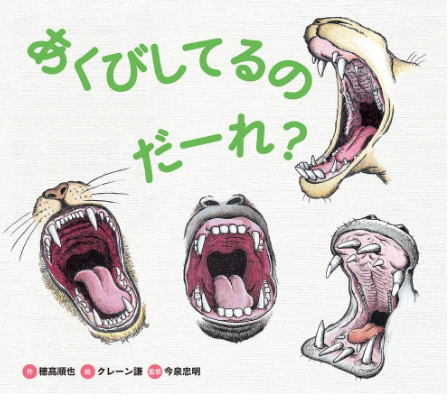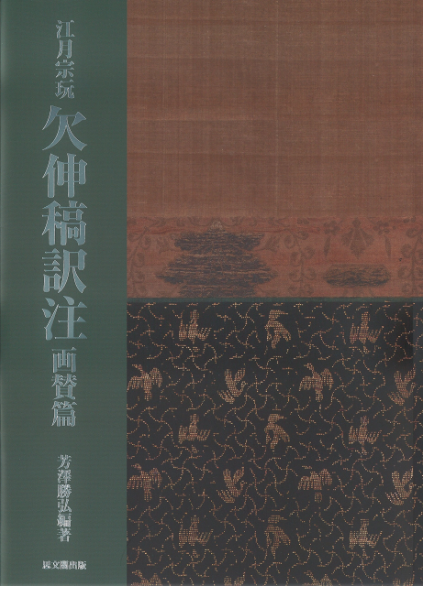76. The "Yawning" Radical: 欠
The four-stroke 欠 shape represents both the "yawning" radical and this autonomous kanji:
欠 (471: lack; to break off; absence; yawning; "yawning" radical)
One can pronounce this character with three Joyo yomi: ケツ, か•ける, and か•く. Despite this abundance of choices, a non-Joyo kun-yomi constitutes the primary way of reading the radical name; we can refer to the 欠 radical in the 欠 kanji as あくび. Here's the scoop on that word:
あくび (欠伸 or 欠: yawn)
The first kanji rendering is ateji; dictionaries break down 欠伸 as yawning + stretching and say that the 伸 doesn’t contribute to the overall meaning of “yawn.” Nor do the sounds of あくび match those of 欠伸.

This children's book poses a question I've admittedly never considered—namely, who yawns in the animal kingdom? We've seen the first word in the title:
「あくびしてるのだーれ?」
Who's Yawning?
The だーれ is simply だれ (誰: who) elongated for emphasis. The Japanese often prolong the next-to-last syllable in a word when speaking to kids.
What Do the Japanese Call the 欠 Radical on the Right?
In the seven other Joyo kanji featuring the 欠 as the on-duty radical, it appears on the right side:
歌 (84: song; poem)
次 (292: next; second; order; ordinal suffix)
歓 (639: joy, happiness)
欲 (987: desire)
欧 (1034: Europe)
款 (1108: stipulation; lump sum; friendly relationship; engraving)
欺 (1136: to deceive)
In these cases, the radical name けんづくり also works. The けん is a non-Joyo on-yomi of the 欠 kanji, and -づくり is the position name for a radical on the right side of a kanji. (To understand this, see Radical Terms and check the fourth section, "Radical Positions.")
Other possible radical names for 欠 are かける and けつ, both of which clearly reflect readings of 欠.
As for English names, "yawning" takes center stage, whereas "gap" and "lack" are backup options.
What Does Yawning Have to Do with It?
I love how 款 (1108), which primarily means "stipulation" and therefore has a close connection to dull legal contracts, features the "yawning" radical! Unfortunately, the etymologies of that character from Henshall's newer edition and from Kanjigen have no connection to yawning. By contrast, yawning does play an etymological role in two kanji that are far more common:
欠 (471: lack; to break off; absence; yawning)
Henshall calls 欠 the pictograph of a "person kneeling and yawning." So far so good, but that's as far as he goes with the consideration of yawning. He calls "lack" an extended sense of a related kanji, the non-Joyo 缺. Although the Japanese have long treated 缺 as a variant (or more precisely a traditional form) of 欠, Henshall deems 缺 a separate character, one that originally meant "damaged pot."
次 (292: next; second; order; ordinal suffix)
The 欠 in this character means "to open the mouth" or "yawn," says Henshall. The remainder isn't the "ice" radical 冫 but rather 二, a phonetic with the associated sense "to stop," "to arrange," or "to follow after." One scholar posits that "yawning indicates taking turns to rest, adding to the idea of following in order."

As we've seen, the first word in the title, 欠伸 (あくび), means "yawn":
「欠伸稿訳注」
Yawn: A Manuscript with the Translator's Notes
稿 (こう: manuscript); 訳注 (やくちゅう: translator's notes)
The work is by 江月宗玩 (こうげつ そうがん: 1574–1643), so the translation is from antiquated to contemporary Japanese. This looks like a very serious treatment of a topic that wouldn't seem to merit scholarly attention. I worry that the deep investigation might actually put readers to sleep.
What Role Does an Open Mouth Play Etymologically?
Letting a yawn escape is not the only reason to open the mouth, of course. We can see that from two other Henshall etymologies:
欲 (987: desire)
The 欠 radical originally meant "person yawning with mouth open wide" but stands for "lack, omit" here. The 谷 phonetic represents "valley" with one of two associated senses—either "continuous" or "about to eat." Either way, the whole character symbolizes "having an open mouth" and by extension "appetite."
欧 (1034: Europe)
The early form was 歐, combining 欠 (open mouth, yawn; lack, be missing; bend over) with 區 (to divide things up small; small). That left-side phonetic conveyed the associated sense "to vomit, disgorge," giving "to open mouth and vomit" as an overall meaning, at least in the opinion of two scholars Henshall cites. Another researcher interprets 欠 as "to bend over." In that case, 歐 represents "to bend over and vomit." Henshall says that the Japanese once used 歐 for its sound, especially (or does he mean only?) to write the word 歐羅巴 (ヨーロッパ: Europe), in which 巴 is non-Joyo. They included 歐 in that context despite or perhaps because of its negative sense! Imagine purposely associating Europe with vomit! Nowadays, the Japanese use just the first kanji from 歐羅巴 to symbolize "Europe," and they have substituted the modern form 欧.
